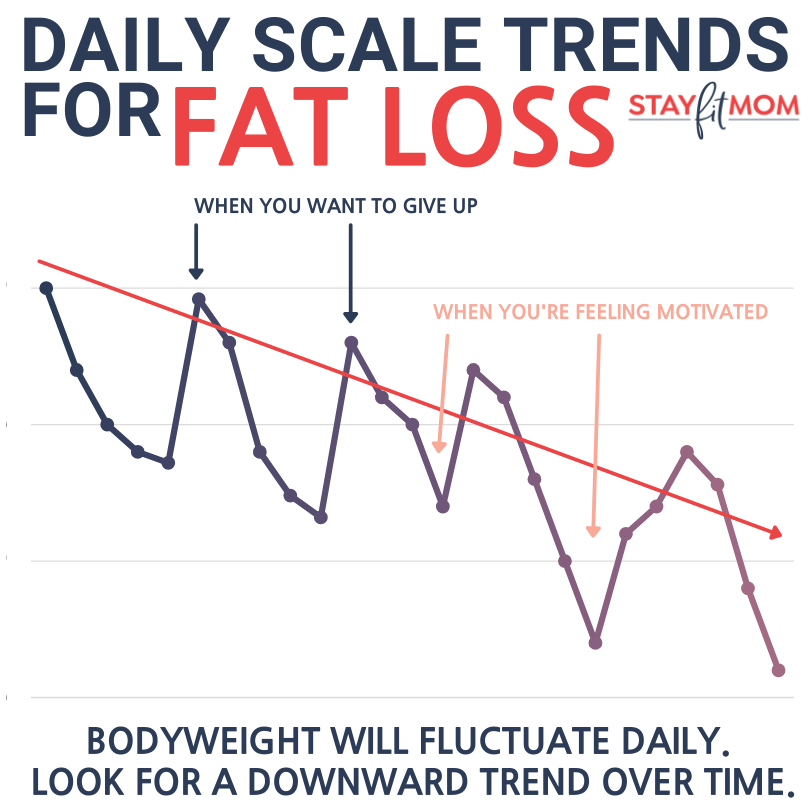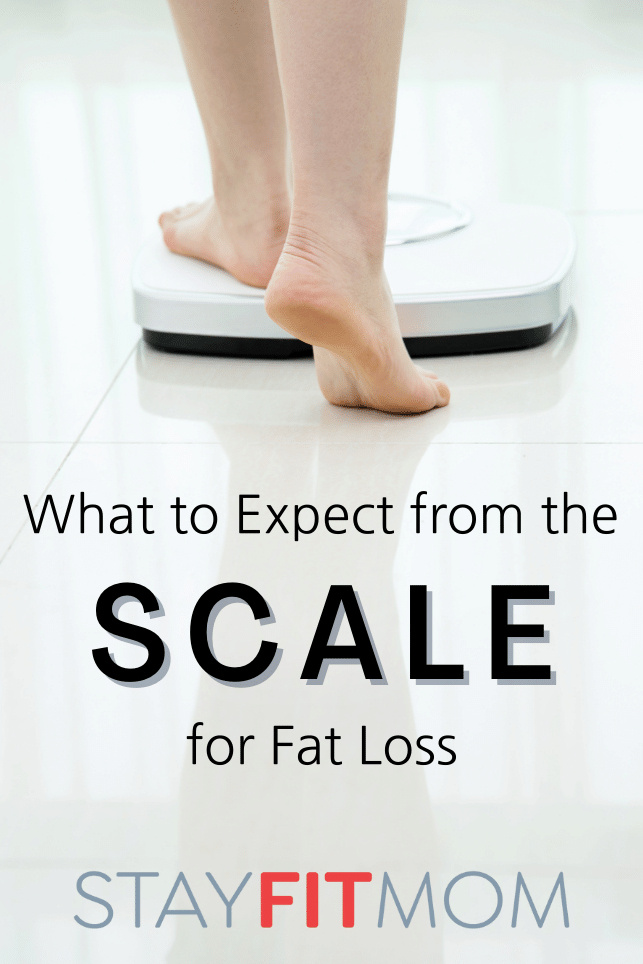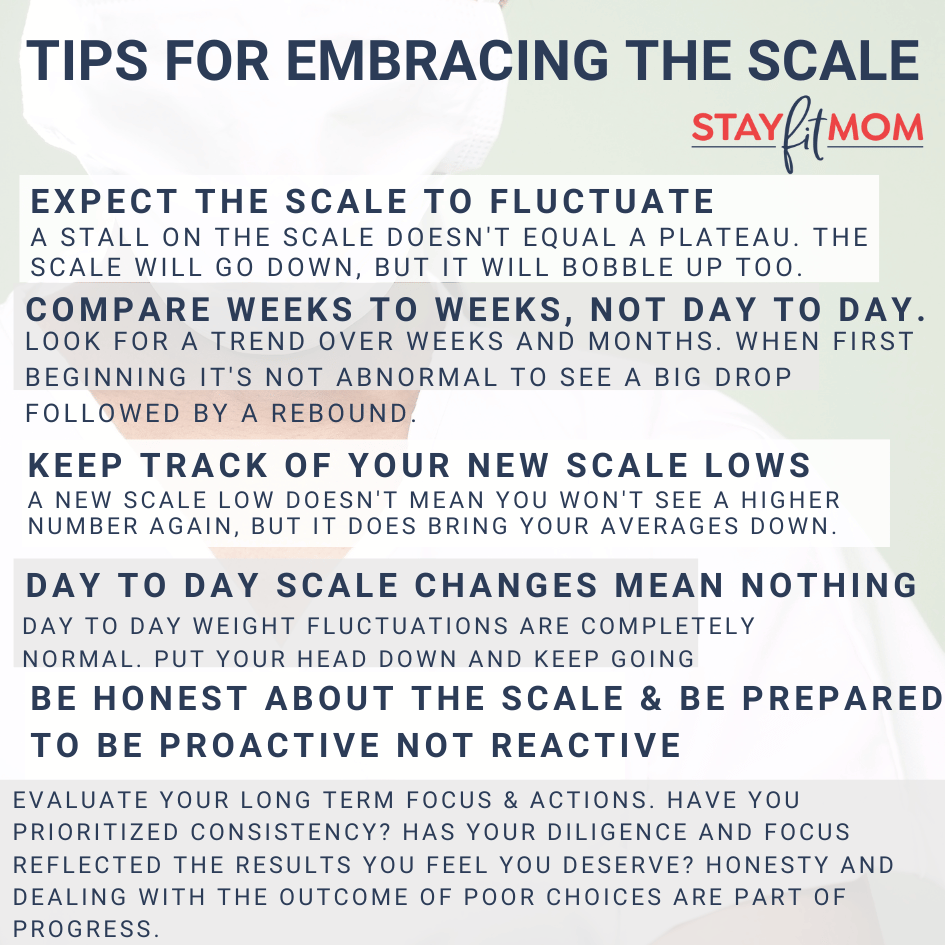When aiming for weight loss, the goal is to see a very gradual trend downward over TIME with consistency and focus. The Downward Scale TREND is a GRADUAL REDUCTION. It’s not a drop off that never quits and only goes down from the start. There WILL be upward spikes, stalls and bobbles along the overall trend. Remember when we learned about slope in math class? Yeah, this chart won’t look like that. It’s messy and full of constant ups and downs. But over time, you will notice that your scale “lows” are getting lower, and your average range is steadily declining. And, I have great news for you! Once you begin a downward trend, the likelihood increases that the trend will continue downward. If you’re wanting to reach your goal weight, but also maintain your goal weight, there will always be ups and downs on the scale along the way. It’s not an if, a possibility, or a maybe. It’s a guarantee. It’s going to happen.
A healthy rate of weight loss is between .5 and 2 lbs a week OVER TIME. Some people will lose a little bit each week. Some will drop more, stall for 3-5 weeks, then lose more. Tracking your trend over a LONG period of time will help you to better understand how to better predict your trend. You may gain a couple before a more significant drop. That’s normal.
Chad Hargrove says,
“The scale is arguably the biggest weight loss enemy you’re best to make friends with. Many hate the scale, but we would hate the books too if we tried to read them upside down.”
In other words, it can be hard to make sense of the scale. This is why the scale leaves us feeling defeated, because we assume those upticks mean we are regressing, not progressing towards our goal of weight loss. But it doesn’t have to be that way!
Tips for utilizing the scale so that it doesn’t make you hate yourself and want to quit.
- Expect the scale to fluctuate. That means it will go not only down, but up too. We often think we DESERVE for the scale to only go down. Maybe we do. But you’ve got to be willing to wait. A stall does NOT equal a plateau. We have to let go of this idea of instant (or even FAST) gratification.
- Compare weeks to weeks, not days to days. This is why at SFM, we tell you to weigh once a week, not every day. HOWEVER, for some women, there can be a ton of fluctuation even during the course of one week. So for some, weighing every day and taking the weekly average can be a better indicator, as long as it doesn’t send you into an emotional tailspin. If you are one that finds it beneficial to weigh daily, use average body weight. Collect your weight for 7 days and use the average. That equates to one weigh in, not 7. Either way, you’re looking at a trend over WEEKS and MONTHS. *NOTE: It’s important to add that for a new client just beginning their coaching journey, it is especially typical to see a 3-4 pound drop within the first week or two, but then a bobble back up for that second weigh in. Don’t let this derail your journey. It’s normal.
- Keep track of your new scale LOW. Maybe you’re used to seeing anywhere from 180-183 on the scale. But suddenly, you weigh one day and the scale says you weigh 178 lbs. That’s great! BUT, let’s say you weigh the next week and you’re back up to 181. That SUCKS. But hold out anyway. Because that 178 was there, and it’s not going anywhere. You’re hitting new lows.
- Day to day scale changes mean absolutely NOTHING. You don’t need to explain it. You don’t need to apologize for it. Weight fluctuates if we are about to get sick, in the thick of sickness, on our period, had alcohol, consumed salty foods, didn’t get good sleep, haven’t pooped, haven’t drank enough water, and the list goes on and on. Ignore it. Put your head down and keep going.
- Be honest about the scale and be prepared to be proactive, never reactive, towards the number. Evaluate your long-term scale trend with your long-term focus and actions. Have you prioritized your consistency (that 13/14 average every two weeks)? Have you planned, measured and tracked, even when you haven’t wanted to? Have you also prioritized fiber, veggies, sleep and water? Has your diligence and focus reflected the results you feel you deserve? Honesty and dealing with the outcome of poor choices are part of progress.
The battle with the scale is like playing Mario Kart. You’re on this course, you’re there with other racers, you hear 3-2-1, and you get going. You don’t know what to expect, but you’re moving and you’re determined to give it your all and do your best. Things are going so well at first, but then you hit a slippery banana and your cart slides. Maybe someone passes you and you lose your spot. You’re discouraged. You’re also frustrated that other racers around you seem to be cruising right along, while you just got bumped farther back. But you keep racing anyway. You’ve got to have the grit to push past the bananas, the squids, the firebombs, etc. I will tell you exactly what it looks like in my household when we play MarioKart as a family. My husband seems to always come in first. It just comes so easily for him, despite my 6 year old and I fighting and yelling through the entire race. Then on the other hand, you have our 3 year old. My husband sets his settings to automatic acceleration, and he just cruises through the race in his own time. He’s just happy to be in the game. That is exactly what it’s like while on a weight loss journey. You see others around you who seem to be making excellent strides. It seems to come naturally for them. Then you have those who are just happy to have the community, camaraderie and support to keep going, no matter how long it takes. Then there’s you. You’re working hard and fighting your way through, but you just can’t seem to stop running over bananas. Those are the upward ticks on the scale. BUT, you know the course is going to end, and you push forward anyway to finish the race. In our case, the “finish line” is our goal weight. Or perhaps it’s just a new scale “low.” We won’t ever see a new scale low if we aren’t okay with those silly bananas that are just part of the game. Remember, a downward trend doesn’t mean a constant slide down. A downward trend is full of upward ticks. The line isn’t sloped. It’s extremely jagged.
The scale is ONE metric that we use to evaluate progress. You have to be realistic with the goal you have, and the number you have in mind. Are you chasing a number, or an aesthetic? If you’re chasing a number, why is that? Are you an athlete? Are you training for a marathon, just in hopes of shedding pounds on the scale? You might end up disappointed. For example, running like a fiend doesn’t always equal a lower number on the scale, if you want to feel good while running. There may come a point where you need to ask yourself, “What am I willing to sacrifice in order to see a particular number on the scale? How uncomfortable am I willing to live?” There’s comfort and flexibility, and then there’s a higher level of focus and being a little uncomfortable. How are you willing to live, in the name of that number?
Many fad “diets” will produce a fast drop on the scale in the beginning. This is especially true for the keto diet, because you are purging your glycogen stores from your muscles when you don’t consume enough carbs. Particularly, 2g of water for every 1g of glycogen. Losing weight with macros is slower because we are ONLY interested in fat loss. We aren’t interested in losing muscle or water.
Along with being trained to just eat less, we are trained to fully expect instant gratification. And when we don’t get it, we’re upset. We think we deserve it. A continuous downward slide just isn’t going to happen. That fast and hard decline on the scale isn’t realistic, nor is it healthy. We all know what I’m about to say next. Not only will the results not last, but we will have rebound weight gain. We will be left feeling deprived, frustrated, self-loathing over yet another failed approach to weight loss that wasn’t even worth doing. We want to reach our goals, but also maintain them. Remember this when you find yourself sitting at the top of those scale peaks, wanting to give up. Your new scale low is just on the horizon.








No Comments